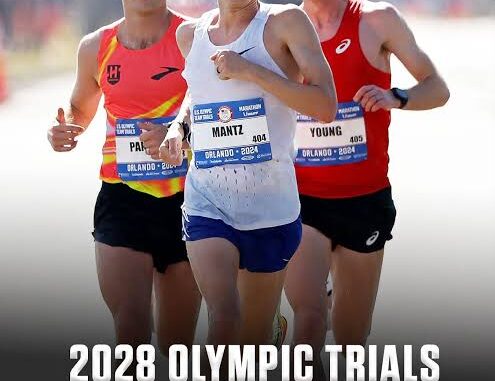
Qualifying window opens September 1, 2025, with new time standards aimed at managing field sizes and supporting elite talent.
The road to the 2028 Olympics has officially begun. On June 2, 2025, USA Track & Field (USATF) announced the qualification standards for the 2028 U.S. Olympic Team Trials in the marathon, setting the stage for America’s top distance runners to compete for a spot in Los Angeles.
The updated standards include a more stringent qualifying time for men, while the women’s standard remains unchanged. For the 2028 Trials, men must run a marathon in 2:16:00 or faster to earn a spot in the field — a two-minute drop from the 2:18:00 standard used for the 2024 Trials. The women’s B-standard remains at 2:37:00.
The qualifying window for marathon performances opens on September 1, 2025, and will close approximately 45–60 days before the Trials, with the final date to be announced following the official confirmation of the event’s host city and date.
USATF has reintroduced the A and B standard system, which had been used in previous Olympic cycles. Athletes who meet the A standard — to be announced later this year — will receive travel and lodging support from the national governing body. Those meeting the B standard will qualify for the Trials but without financial assistance.
In addition to marathon times, athletes can also qualify with a half-marathon performance. The half-marathon qualifying window opens later, on January 1, 2027, with times of 1:03:00 for men and 1:12:00 for women being accepted. All performances must be recorded during certified races and will be evaluated based on chip time, not gun time, ensuring a more equitable measurement regardless of starting position.
USATF is also offering several alternative pathways to qualification. Athletes can qualify by finishing in the top 10 at select U.S. Championship marathons, placing in the top 10 at World Athletics Platinum Label races (such as Boston or Chicago), or by winning the USATF Running Circuit in 2026 or 2027. Past Olympic or World Championship marathon team members — dating back to 2016 — are also automatically qualified.
According to USATF, the new standards are part of an effort to manage field sizes — targeting around 200 qualifiers per gender — while maintaining competitive integrity and athlete support. The decision to tighten the men’s standard reflects the increasing depth in U.S. men’s distance running, while keeping the women’s standard steady ensures continuity and fairness.
The return to an A/B standard structure is a welcome shift for many in the elite running community, offering clear incentive for top performances and financial support for those most likely to contend for Olympic team spots.
As anticipation builds toward the 2028 Games in Los Angeles, athletes, coaches, and fans will be watching closely to see who earns the right to compete on one of the biggest stages in sports. The “Road to the Trials” begins this fall — and for many runners, the chase is already on.



Be the first to comment